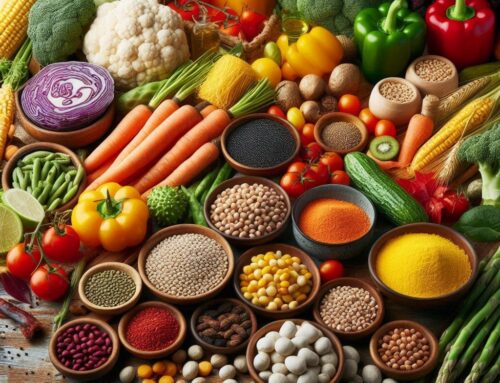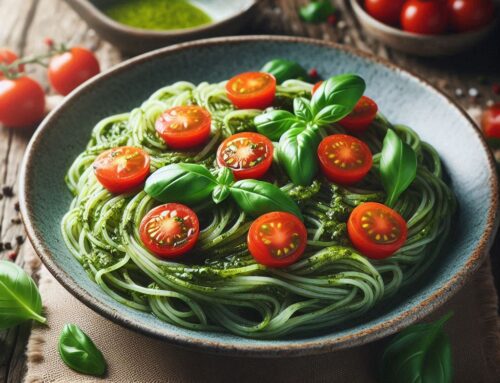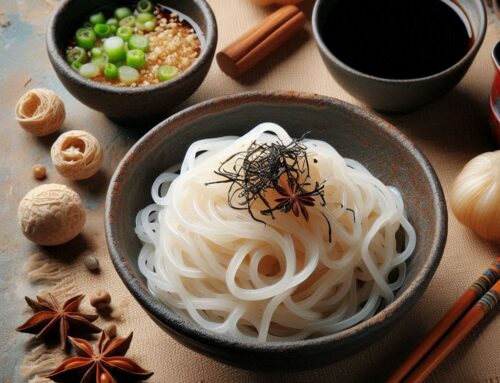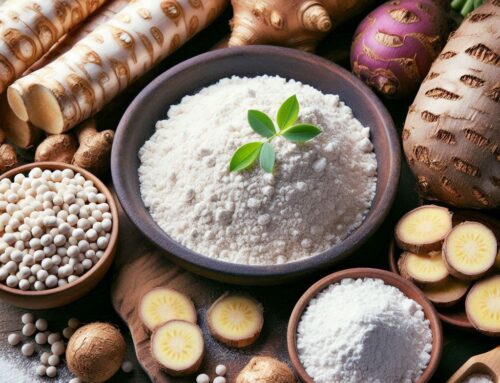
Introduction to Konjac: What is it and Where Does it Come From?
Konjac is a fascinating plant that has been gaining popularity in the health and wellness community, primarily due to its unique properties and benefits. Originating from Southeast Asia, the konjac plant thrives in tropical and subtropical regions. It has been used for centuries in countries like Japan, China, and Indonesia for both culinary and medicinal purposes.
The most notable part of the konjac plant is its root, which is rich in a dietary fiber known as glucomannan. This water-soluble fiber is celebrated for its ability to absorb large amounts of water, transforming into a gel-like substance that can aid digestion and promote feelings of fullness. As such, glucomannan extracted from the konjac root is often used as a dietary supplement to support weight management.
Beyond supplements, the konjac root’s versatility extends to various food products. Konjac flour is used to make low-calorie noodles and rice alternatives that are popular among those seeking healthier options without compromising on texture or taste. Whether incorporated into meals or taken as a supplement, konjac offers an intriguing blend of tradition and modern health benefits worth exploring further.
The Nutritional Benefits of Konjac
Konjac, a plant native to Asia, has garnered attention for its impressive nutritional profile and potential health benefits. Known for its low-calorie content, konjac is an excellent choice for those seeking weight management aids. The root of the konjac plant is used to produce glucomannan, a dietary fiber that expands in the stomach when consumed with water, promoting a feeling of fullness and reducing overall calorie intake.
One of the key health benefits of konjac is its role in supporting digestive health. As a soluble fiber, glucomannan helps regulate bowel movements and can alleviate symptoms of constipation. Additionally, studies suggest that this fiber may aid in managing blood sugar levels by slowing down the absorption of carbohydrates.
The nutrition facts of konjac highlight its suitability as part of a balanced diet. It contains minimal calories while being rich in fiber—a combination that supports weight loss efforts without sacrificing nutritional value. Moreover, konjac is often included in various low-calorie foods like shirataki noodles and gelatinous snacks, providing versatile options for those looking to incorporate it into their meals.
In summary, embracing konjac as part of your dietary routine can offer numerous advantages. From aiding weight management to enhancing digestive health, this humble plant serves as a powerful ally in achieving nutritional goals while maintaining overall well-being.
Exploring the Potential Risks: Is Konjac Safe for Everyone?
Konjac, a plant native to Asia, has gained popularity as a health food due to its low-calorie content and high fiber levels. However, it’s essential to explore the potential risks associated with its consumption to determine if konjac is safe for everyone.
One of the primary concerns regarding konjac safety is the possibility of allergic reactions. Although rare, some individuals may experience allergies when consuming konjac products. Symptoms might include itching, swelling, or difficulty breathing. It’s crucial for those with known food allergies to consult with a healthcare professional before incorporating konjac into their diet.
Another area of concern is digestive health. Konjac contains glucomannan, a soluble fiber that can aid digestion but may also cause gastrointestinal issues such as bloating or diarrhea in sensitive individuals. It’s advisable for newcomers to introduce konjac gradually into their diet and monitor how their body responds.
Additionally, there is a choking hazard associated with certain konjac products, particularly jelly snacks. These snacks have been banned in some countries due to reports of choking incidents among children and the elderly. To mitigate this risk, it’s important to consume konjac products in forms that are safe and manageable.
In conclusion, while konjac offers several health benefits, it may not be suitable for everyone due to potential allergic reactions and digestive concerns. Being aware of these risks allows individuals to make informed decisions about including konjac in their dietary regimen safely.
Toxicity Concerns: What Experts Say About Consuming Konjac
When it comes to the consumption of konjac, a plant-based product used in various dietary supplements and foods, there are some toxicity concerns that consumers should be aware of. The question “Is konjac toxic?” often arises due to its unique properties and effects on the digestive system. According to food safety experts, konjac itself is not inherently toxic; however, its consumption does require caution.
Konjac is primarily composed of glucomannan, a soluble fiber known for its ability to absorb water and expand in the stomach. This characteristic can be both beneficial for weight management and potentially hazardous if not consumed properly. Food safety experts emphasize that excessive intake without adequate hydration can lead to gastrointestinal blockages or choking hazards, particularly with products like konjac jelly candies.
The FDA has issued guidelines on konjac products to ensure consumer safety. These guidelines suggest that manufacturers provide clear instructions on proper usage and emphasize the importance of consuming these products with plenty of water. Additionally, certain forms of konjac have been banned in specific countries due to safety concerns related to choking risks.
In conclusion, while konjac is not toxic per se, responsible consumption following expert advice and adhering to FDA guidelines is crucial for ensuring safety when incorporating it into your diet. As always, consulting with healthcare professionals before making significant dietary changes is recommended.
The Role of Konjac in Weight Loss Programs and Diet Plans
Konjac, a plant native to Asia, has gained significant attention in the realm of weight loss programs and diet plans, primarily due to its high content of glucomannan. This natural dietary fiber is renowned for its ability to support weight management efforts. Glucomannan supplements derived from konjac work as an effective appetite suppressant by absorbing water and expanding in the stomach, which promotes a feeling of fullness and reduces overall calorie intake.
The unique properties of glucomannan make it an excellent addition to any diet plan aiming for sustainable weight loss. Its ability to slow down the digestive process not only helps in controlling hunger pangs but also aids in stabilizing blood sugar levels, which can prevent sudden spikes that often lead to cravings. Moreover, konjac’s low-calorie nature ensures that it contributes minimally to daily caloric intake while maximizing satiety.
Incorporating konjac into a weight loss regimen can be done through various forms such as noodles, rice alternatives, or direct supplementation with glucomannan capsules. However, it’s essential for individuals considering these supplements to consult with healthcare professionals before starting any new dietary regimen, especially those with existing health conditions or those taking medication. By understanding how konjac functions within the body and aligning its use with personalized health goals, individuals can effectively leverage its benefits as part of their journey towards healthier living.
Incorporating Konjac into Your Diet Safely
Incorporating konjac into your diet can be a wonderful way to enjoy its health benefits, but it’s important to do so safely. Konjac, known for its high glucomannan content, is commonly found in noodle or rice form and can be a great low-calorie alternative to traditional carbohydrates. When cooking with konjac noodles or rice, it’s crucial to rinse them thoroughly under cold water to remove any unpleasant odor they may have due to the natural compounds in the plant.
To eat konjac safely, start by introducing it gradually into your diet. This helps your digestive system adjust and reduces the risk of gastrointestinal discomfort. The recommended daily intake of glucomannan is about 3 grams per day, which can typically be achieved through one or two servings of konjac-based foods. It’s also essential to drink plenty of water when consuming konjac products, as glucomannan absorbs water and expands in the stomach, promoting a feeling of fullness.
By following these guidelines on how to eat konjac safely and incorporating it mindfully into your meals, you can enjoy its unique texture and nutritional benefits without any adverse effects.
Conclusion: Balancing the Benefits and Risks of Konjac Consumption for Optimal Health
In conclusion, the consumption of konjac offers both notable benefits and potential risks that require careful consideration for optimal health. Konjac, rich in glucomannan, is celebrated for its ability to aid in weight management by promoting a feeling of fullness and reducing overall caloric intake. Its high fiber content also supports digestive health by facilitating regular bowel movements and improving gut flora balance.
However, it’s important to be mindful of the potential risks associated with konjac consumption. For some individuals, especially those unaccustomed to high-fiber diets, konjac can cause gastrointestinal discomfort such as bloating or gas. Additionally, due to its highly absorbent nature, konjac products should always be consumed with adequate water to prevent choking hazards or intestinal blockages.
For those considering incorporating konjac into their diet, moderation is key. Consulting with a healthcare professional can provide personalized advice based on individual dietary needs and health conditions. By balancing these factors thoughtfully, individuals can enjoy the health benefits of konjac while minimizing any adverse effects.






